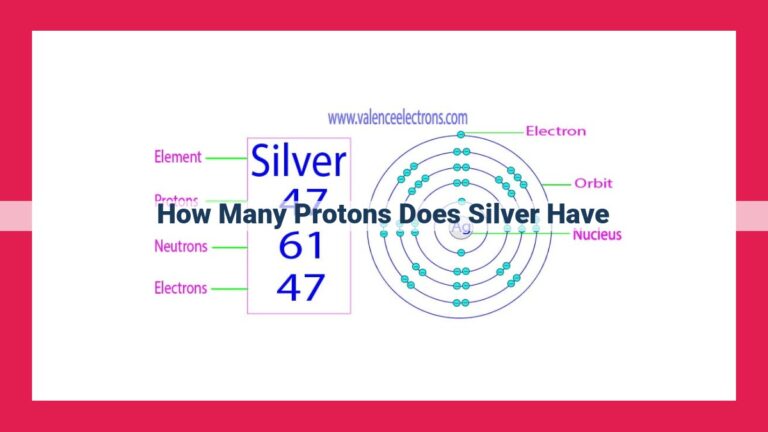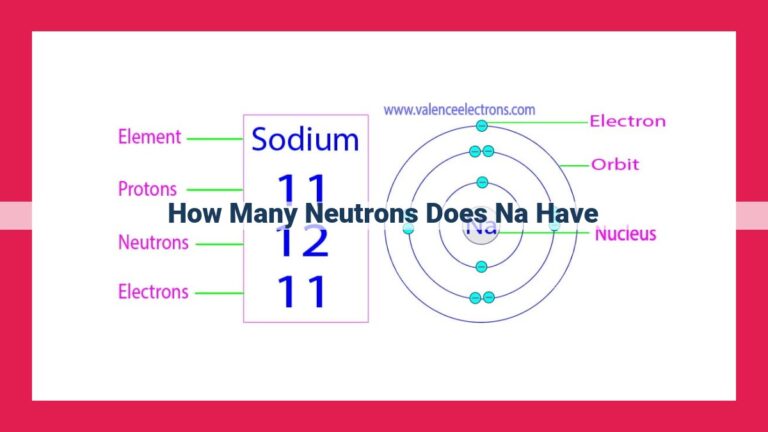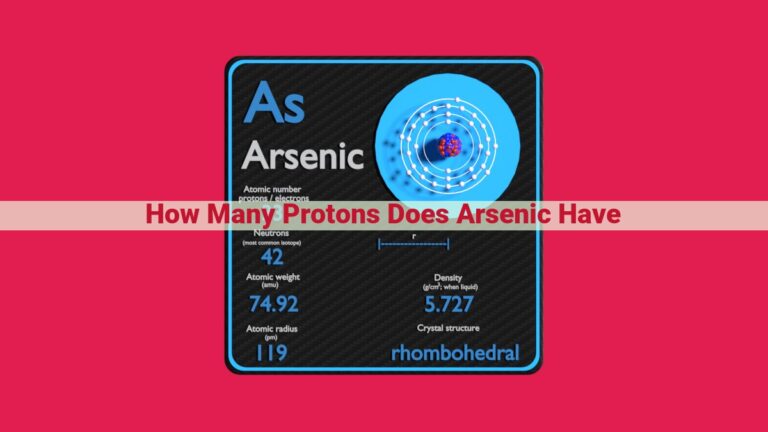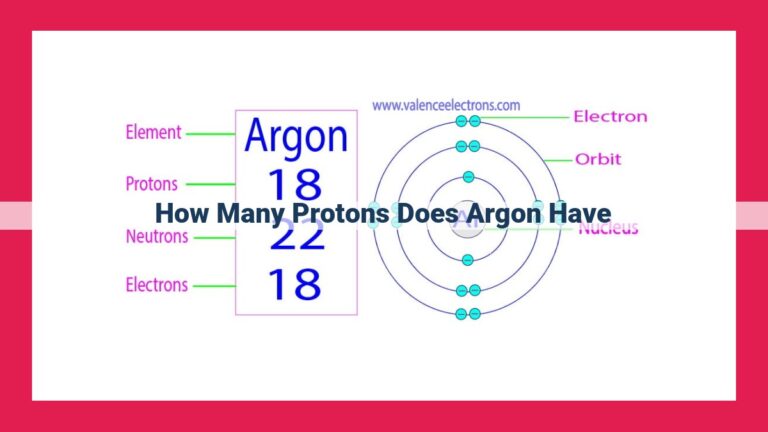Unveiling The Neutron Number: Its Significance In Arsenical Isotope Identification And Atomic Structure
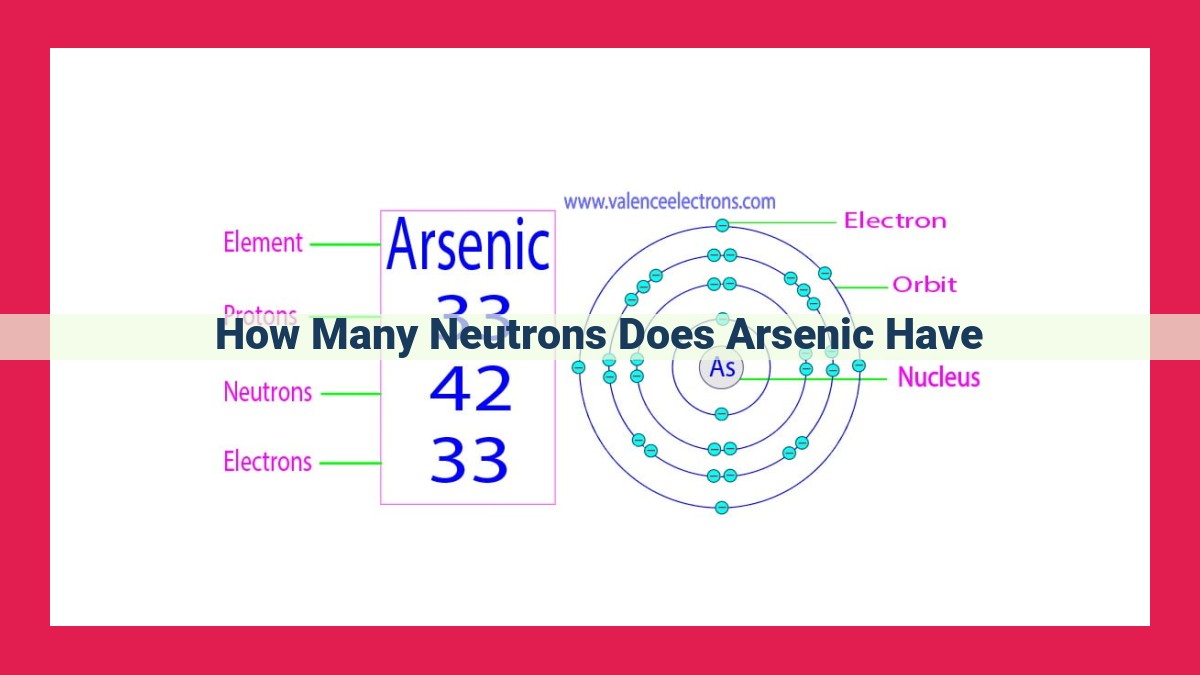
Arsenic, an element with atomic number 33, possesses 42 neutrons in its nucleus. The neutron number, denoted by N, is calculated as the difference between the mass number (A) and the atomic number (Z). In the case of arsenic, A = 75, resulting in N = A – Z = 75 – 33 = 42. Understanding neutron numbers aids in distinguishing isotopes, atoms of the same element with varying neutron counts, and provides valuable insights into atomic structure and properties.
The Enigmatic Neutrons: Guardians of Atomic Secrets
In the intricate tapestry of the atomic world, neutrons reign as enigmatic but crucial players, silently shaping the properties and stability of every element. These unassuming subatomic particles, dwelling in the heart of the atom, hold the key to unlocking the secrets of matter.
Neutrons: The Unsung Heroes of Atomic Stability
Unlike their charged counterparts, protons and electrons, neutrons possess a neutral electrical nature. Their presence in the atom’s nucleus, alongside protons, contributes to the overall mass and stability of the element. By counterbalancing the electrostatic repulsion between protons, neutrons maintain a harmonious atomic equilibrium.
Their role goes beyond mere spectators. The neutron number, a fundamental characteristic of an atom, reveals the number of neutrons it harbors within its nucleus. This number plays a pivotal role in distinguishing isotopes of the same element. Isotopes share the same number of protons but differ in neutron count, leading to variations in atomic weight and properties.
Exploring the Neutron Number
The neutron number (N) is calculated by subtracting the atomic number (Z) from the mass number (A). The atomic number represents the number of protons, defining an element’s identity, while the mass number is the sum of protons and neutrons.
For instance, consider arsenic, an element with an atomic number of 33. Using the formula N = A – Z, we find that arsenic’s neutron number is 42. This information unveils the number of neutrons residing within the arsenic atom’s nucleus, contributing to its unique atomic characteristics.
Neutrons: A Window into Atomic Diversity
The neutron number opens a window into the fascinating realm of isotopes, isobars, and isotones. Isotopes are atoms of the same element with varying neutron numbers, resulting in different isotopic masses. Isobars share the same mass number but differ in atomic number, indicating different elemental identities. Isotones, on the other hand, share the same neutron number but possess distinct atomic numbers, belonging to different elements.
Understanding the neutron number empowers scientists to decipher the intricacies of atomic structure, paving the way for breakthroughs in nuclear physics, chemistry, and other scientific disciplines. From the birth of stars to the diagnosis of medical conditions, neutrons continue to fascinate and inspire.
Neutron Number: A Key Determinant in Atomic Structure
Neutrons, the enigmatic particles that reside in the heart of atoms, play a vital role in shaping an atom’s properties and stability. Understanding their importance begins with comprehending the concept of neutron number.
Definition: The Neutron Number
The neutron number, denoted by the symbol N, represents the number of neutrons present in an atom’s nucleus. It is essential in distinguishing between different isotopes of the same element, which have varying numbers of neutrons while sharing the same number of protons.
Formula for Calculating Neutron Number
The neutron number can be calculated using the following formula:
N = A - Z
where:
- A is the mass number, which is the total number of protons and neutrons in the nucleus.
- Z is the atomic number, which is the number of protons in the nucleus and determines the element’s identity.
Significance of Neutron Number
The neutron number contributes significantly to an atom’s identity and stability. For instance, isotopes with different neutron numbers can exhibit distinct physical and chemical properties due to their varying mass and neutron-to-proton ratios. Additionally, the neutron number influences an atom’s radioactivity and nuclear stability.
Example: Determining Neutron Number in Arsenic
Arsenic, with an atomic number of 33, has 33 protons in its nucleus. To determine the neutron number of arsenic, we use the formula:
N = A - Z
Assuming an arsenic isotope with a mass number of 75, we have:
N = 75 - 33 = 42
Therefore, this arsenic isotope has 42 neutrons in its nucleus.
The neutron number serves as a crucial determinant of an atom’s characteristics and behavior. Understanding its significance empowers us to comprehend the intricacies of atomic structure, distinguish between isotopes, and delve deeper into the fascinating world of nuclear physics.
Related Concepts in Atomic Structure
- Mass number (A): Sum of protons and neutrons
- Atomic number (Z): Number of protons, determining element identity
Understanding the Neutron Number: A Key to Atomic Structure
In the vast atomic universe, neutrons play a crucial role in shaping the properties and stability of elements. They are subatomic particles, found within the nucleus alongside protons and electrons. While neutrons carry no electrical charge, their presence significantly influences the atomic structure, paving the way for a deeper understanding of matter.
Neutron Number: A Key Characteristic
Every atom possesses a specific number of neutrons, known as the neutron number, denoted by the symbol N. This number is fundamental in determining the atomic mass and distinguishing between isotopes of the same element. Isotopes share the same atomic number but differ in neutron count, leading to variations in certain physical and chemical properties.
Related Concepts in Atomic Structure
To fully grasp the significance of the neutron number, it’s essential to understand related concepts in atomic structure:
- Mass Number (A): The mass number represents the total number of protons and neutrons within an atom’s nucleus. It is calculated by adding the number of protons (Z) to the number of neutrons (N).
- Atomic Number (Z): The atomic number, unique to each element, indicates the number of protons in an atom’s nucleus. It determines the element’s identity and position on the periodic table.
Isotopes, Isobars, and Isotones
The neutron number plays a critical role in classifying different types of atoms:
- Isotopes: Atoms with the same atomic number (Z) but different neutron numbers (N) are called isotopes. They share identical chemical properties but may vary in physical properties due to differences in mass.
- Isobars: Atoms with the same mass number (A) but different atomic numbers (Z) are known as isobars. They possess similar masses but exhibit distinct chemical properties.
- Isotones: Atoms with the same neutron number (N) but different atomic numbers (Z) are called isotones. They share similar nuclear properties but differ in chemical behavior.
Calculating the Neutron Number of Arsenic
To illustrate the importance of the neutron number, let’s determine the neutron number of arsenic (As). Arsenic’s atomic number is 33, which indicates the number of protons in its nucleus. The neutron number (N) can be calculated using the formula:
N = A - Z
Where:
- N: Neutron number
- A: Mass number
- Z: Atomic number
Since the mass number of arsenic is 75, we can substitute the values:
N = 75 - 33
Thus, the neutron number of arsenic is 42.
The neutron number provides a critical lens through which we can understand atomic structure. It distinguishes between isotopes, revealing their varied properties. Furthermore, it plays a vital role in comprehending the behavior of atoms and the formation of chemical bonds. By unlocking the secrets of the neutron number, we gain a deeper appreciation for the intricate world of matter that surrounds us.
Understanding the Quirks of Atomic Structure: Isotopes, Isobars, and Isotones
As you delve into the captivating world of atomic structure, you encounter a trio of fascinating terms: isotopes, isobars, and isotones. Each holds a unique secret, revealing the intricacies of atoms and their remarkable diversity.
Isotopes: The Siblinghood of Elements
Imagine the family of elements, each with its own unique identity card, the atomic number. This number, symbolized by Z, tells you how many protons reside within the nucleus. Now, what if you could have multiple siblings with the same parent (atomic number), each with a different number of neutrons? That’s where isotopes come into play.
Isotopes are like siblings within an element’s family, sharing the same atomic number but sporting a different number of neutrons in their nuclei. These variations in neutron number lead to isotopes of the same element having slightly different masses and properties. For instance, carbon-12, carbon-13, and carbon-14 are all isotopes of carbon, with 6, 7, and 8 neutrons, respectively.
Isobars: The Balancing Act of Mass
Now, let’s flip the script and consider a different scenario. Instead of keeping the atomic number constant, what if we maintain the total number of nucleons (protons + neutrons), known as the mass number (A)? Enter isobars, atoms with different atomic numbers but the same mass number.
Isobars are the balancing act of atomic structure. They represent atoms with the same mass but different identities. For example, potassium-40 (19 protons, 21 neutrons) and calcium-40 (20 protons, 20 neutrons) are isobars with the same mass number of 40.
Isotones: The Harmony of Neutrons
Finally, we have isotones, the harmonious counterparts of isotopes and isobars. These are atoms of different elements with the same number of neutrons. It’s like having siblings from different families sharing the same love for music (neutrons).
Isotones share the same number of neutrons, but their protons and overall charge differ. For instance, nitrogen-14 (7 protons, 7 neutrons) and oxygen-15 (8 protons, 7 neutrons) are isotones, both possessing seven neutrons.
Understanding these concepts is crucial for unraveling the mysteries of atomic structure and the diverse array of elements that make up our universe. So, as you delve deeper into the realm of chemistry, remember these atomic quirks: isotopes, isobars, and isotones – the fascinating building blocks of our world.
The Significance of Neutrons: Delving into the Heart of Atomic Structure
In the vast tapestry of the atomic realm, neutrons play a pivotal role, shaping the very properties and stability of atoms. As we embark on a journey to unravel the mysteries of these elusive particles, let’s delve into the concept of neutron number and explore its profound significance.
Neutron Number: A Defining Characteristic
At the heart of every atom lies the nucleus, where protons determine the element’s identity and neutrons provide a stable foundation. The neutron number (N) represents the number of neutrons within the nucleus. This number, alongside the atomic number (Z), dictates the unique characteristics of each atomic species.
Interwoven Concepts in Atomic Structure
To fully grasp the significance of neutron number, we must first acquaint ourselves with related concepts. Mass number (A) denotes the total number of protons and neutrons within the nucleus, while atomic number (Z) represents the number of protons, defining the element’s chemical identity.
Isotopes, Isobars, and Isotones: Exploring the Nuances
Isotopes are atoms of the same element with identical atomic numbers but varying neutron numbers. Isobars, on the other hand, share the same mass number but differ in atomic number, indicating different elements. Finally, isotones are atoms with equal neutron numbers but distinct atomic numbers.
Calculating the Neutron Number of Arsenic: A Practical Example
Let’s embark on a practical exploration by determining the neutron number of arsenic. First, we identify its atomic number: 33. Using the formula N = A – Z, we can calculate the neutron number as follows:
N = A - Z
= 75 - 33
= 42
Therefore, arsenic has 42 neutrons within its nucleus.
Understanding the concept of neutron number is crucial in deciphering the intricate tapestry of atomic structure. By delving into the complexities of isotopes, isobars, and isotones, we gain a deeper appreciation of the diversity and uniqueness of the atomic world. The neutron number serves as a profound tool, unlocking the secrets of atomic properties and stability. Through its comprehension, we unlock the building blocks of matter and deepen our understanding of the universe around us.
